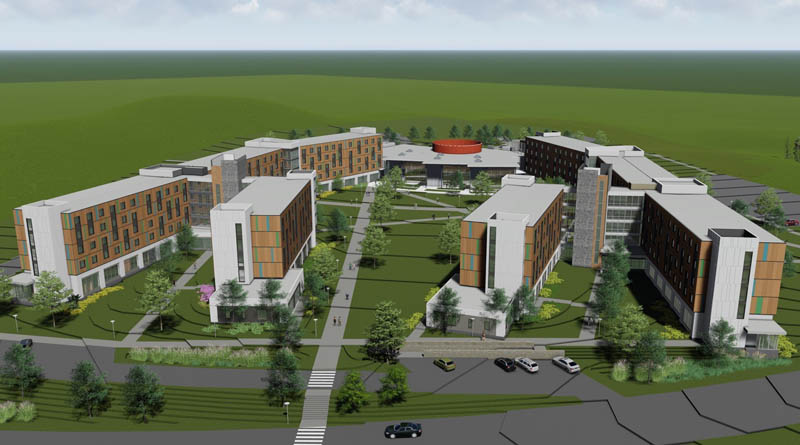UMass Dartmouth Breaks Ground on $134 Million Complex
By Aziza Jackson
DARTMOUTH, Mass. — The University of Massachusetts Dartmouth recently broke ground on a $134 million housing and dining complex designed to transform the student living and learning experience on campus. The project will create 150 construction jobs and 400,000 people hours of work. The facilities will open when students arrive for classes in fall 2020.
The complex, which is being built in Parking Lot 7 near the university’s Campus Center and College of Visual and Performing Arts, will include a $108 million, 1,210-bed, 267,500-square-foot housing complex in two buildings. In addition to the actual living areas, the facilities will include general academic classrooms, multimedia and study lounges, demonstration kitchens, and recreation spaces. The buildings will also offer technology-equipped maker spaces where students will be able to work on group projects, soundproof music practice spaces, and two computer learning commons. Two faculty-in-residence apartments will foster mentoring and advising. The new housing will replace four residence halls that opened in 1976.
The new complex will also include a $26 million, 38,000-square-foot, student dining commons with a capacity of 800. The facility will be designed with a marketplace concept that will expand food options in response to students’ needs and expectations. The design will include a large flat top grill where students will be able to see their meals being prepared. The university’s current main dining hall was built in 1977 for a residential student population of 1,600 but now serves more than 3,000 students daily.
While the housing and dining complex is being built, work will also begin on a $54 million renovation of the Science and Engineering Building, supported by $25 million in state funds. Together, these projects represent the first phase of Chancellor Robert E. Johnson’s plan to focus capital investment on the 710-acre UMass Dartmouth main campus, which has seen just one major state-funded building project, the Claire T. Carney Library renovation, since 1980. Future initiatives include renovation and modernization of academic buildings, the campus center, road infrastructure, and athletic facilities.
“Our students and our region will benefit from these investments in quality living and learning facilities that will prepare them to succeed in a rapidly changing, highly competitive global economy,” said UMass Dartmouth Chancellor Robert E. Johnson. “I am thankful for the support that we are receiving from the Baker-Polito Administration, President Meehan and our Board of Trustees, and our SouthCoast Legislative delegation, as we pursue our aspirations through this innovative and collaborative strategy. When combined with our first-rate faculty, these facilities will guarantee our students the private college educational experience and public university value they so deserve.”
The residence halls will be built through a public-private partnership between the university and Greystar, one of the largest collegiate housing developers and managers in the country. The partnership will allow the building of the new housing without any state taxpayer funds and will not add to the debt burden for the university.
The project construction will be led by Suffolk, which has built nine residential facilities on campus, including the 800-bed Pine Dale and Oak Glen halls, which opened in 2003, and the 1,200-bed Woodland apartment complex, which opened in 2005.
The project is being financed via the UMass Building Authority and designed by DiMella Shaffer, which has been recognized by ARCHITECT magazine as one of the “Top 50 Firms in Sustainability.”
“Through this public-private partnership, and our partners at Greystar and Suffolk, we’re transforming spaces where UMass Dartmouth students will live, learn, eat, and play,” said Randy Kreie, principal and president of DiMella Shaffer. “Our team has worked in collaboration with the university from the beginning and we are excited to deliver a facility that will meet the unique needs of their students and faculty for decades to come.”

